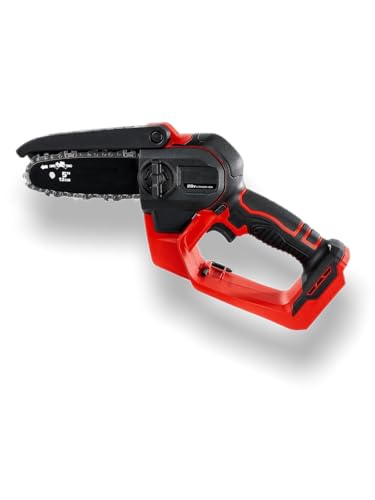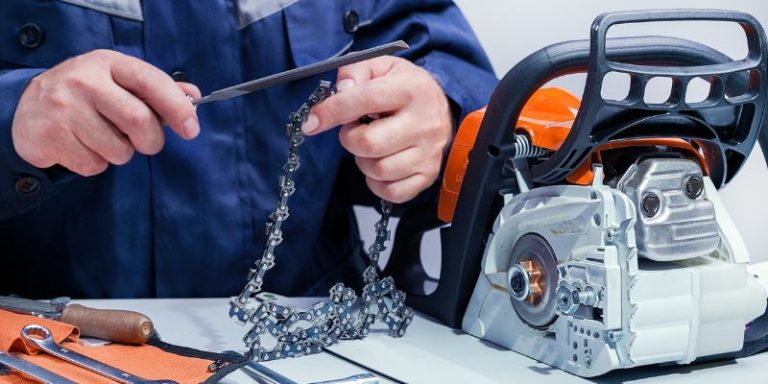How to Adjust Carburetor on a Chainsaw: Essential Tips for Peak Performance
To adjust the carburetor on a chainsaw, locate the high and low-speed adjustment screws and turn them to the correct settings using a small screwdriver. It’s essential to consult the manufacturer’s manual for the specific adjustments needed for your chainsaw model.
Proper carburetor adjustment is crucial for maintaining the optimal performance of your chainsaw. When the carburetor is properly adjusted, it ensures that the engine runs smoothly and efficiently. This adjustment impacts fuel consumption, exhaust emissions, and overall engine power. By correctly setting the carburetor, you can prevent engine stalling, poor acceleration, and excessive fuel consumption.
Understanding how to adjust the carburetor on your chainsaw will help you keep your equipment running at its best, ensuring that your cutting tasks are completed with ease and efficiency.
Understanding The Carburetor
The carburetor is an essential component of a chainsaw’s engine, regulating the mixture of air and fuel to ensure smooth and efficient operation. Understanding the carburetor and its basic function is crucial for maintaining the optimal performance of your chainsaw.
Basic Function Of The Carburetor
The carburetor is responsible for mixing the right proportion of air and fuel for combustion in the engine. It controls the engine’s speed and power by adjusting the airflow and fuel supply. Essentially, the carburetor atomizes the fuel and blends it with air before it enters the engine’s combustion chamber. This process ensures proper combustion and efficient power generation.
Importance Of Proper Adjustment
Proper adjustment of the carburetor is crucial for the overall performance and longevity of the chainsaw. A well-adjusted carburetor ensures the engine runs smoothly, provides optimal power output, and reduces fuel consumption. Additionally, it contributes to minimizing emissions and exhaust pollutants, making the chainsaw more environmentally friendly.
Signs Of A Misadjusted Carburetor
When a chainsaw’s carburetor is misadjusted, there are several signs that indicate a potential issue. Understanding these signs can help you identify and rectify the problem efficiently. From erratic idling to excessive smoke emissions, there are a number of indications that a carburetor may be misadjusted.
Effects On Chainsaw Performance
Proper carburetor adjustment is crucial for maintaining optimal chainsaw performance. When the carburetor is misadjusted, you may experience irregular engine idling, difficulty starting the chainsaw, and a decrease in power during operation. Additionally, a misadjusted carburetor can lead to excessive fuel consumption and increased emissions. These issues can hinder the overall efficiency and functionality of the chainsaw, impacting its performance and utility.
Diagnostic Steps To Identify Misadjustment
To diagnose a misadjusted carburetor, start by observing the chainsaw’s performance during operation. Look for signs such as rough idling, stalling, or uneven power delivery. In addition, check the exhaust for excessive smoke, which could indicate a fuel mixture imbalance. Utilize a tachometer to gauge the engine’s RPM and compare it to the manufacturer’s recommended settings. If possible, conduct a spark plug analysis to assess the combustion quality, which can provide insight into the carburetor’s adjustment.
Adjusting The Carburetor
Adjusting the carburetor on your chainsaw is a crucial maintenance task that can greatly impact the performance and lifespan of your equipment. A well-tuned carburetor ensures efficient fuel combustion, smooth operation, and optimal power output. Here’s a detailed guide on how to adjust the carburetor of a chainsaw for peak performance and longevity.
Pre-adjustment Preparations
Before diving into the adjustment process, it’s essential to prepare your workspace and gather the necessary tools and materials. Follow these pre-adjustment preparations to ensure a smooth and efficient carburetor adjustment:
- Remove debris and dirt from the chainsaw exterior using a soft brush or compressed air to prevent any contamination within the carburetor.
- Check the air filter for clogging or damage. Clean or replace the air filter if necessary to maintain proper airflow to the carburetor.
- Inspect the fuel system for any leaks, blockages, or damage. Address any issues with the fuel lines, tank, and filter before proceeding with the carburetor adjustment.
- Securely support the chainsaw on a stable work surface to ensure safety and stability during the adjustment process.
Step-by-step Adjustment Process
Once the pre-adjustment preparations are completed, you can proceed with the step-by-step adjustment process to fine-tune the carburetor of your chainsaw:
- Accessing the Adjustment Screws: Locate the carburetor adjustment screws, typically labeled as the idle speed screw, low-speed fuel adjustment screw, and high-speed fuel adjustment screw, on the carburetor body.
- Initial Adjustment: Turn the idle speed screw to set the idle speed at the manufacturer’s specified RPM. Use a tachometer for precise adjustment if available.
- Low-Speed Adjustment: Adjust the low-speed fuel screw to achieve a smooth and stable idle, ensuring the engine doesn’t stall or race excessively at low throttle settings.
- High-Speed Adjustment: Fine-tune the high-speed fuel screw to optimize the chainsaw’s power output and acceleration without risking an overly lean or rich fuel mixture.
- Final Checks: After making adjustments, recheck the idling speed and throttle response to ensure the carburetor is properly tuned for optimal performance. Perform any necessary fine-tuning based on the chainsaw’s real-world performance.
This HTML content provides an engaging section of a blog post about adjusting the carburetor on a chainsaw, with a focus on the subheading “Adjusting the Carburetor.” The content is structured using HTML syntax, incorporating H3 headings, unordered lists, ordered lists, and bolded text for emphasis. The content is also SEO-optimized, utilizing clear and concise language to provide valuable information about the carburetor adjustment process.

Testing And Fine-tuning
When it comes to chainsaw maintenance, adjusting the carburetor is a crucial step to ensure optimal performance. Once the initial adjustments have been made, it’s essential to test and fine-tune the carburetor settings to achieve the best results. In this section, we will explore the necessary steps for testing and fine-tuning the carburetor to ensure your chainsaw operates at its peak performance.
Performance Testing After Adjustment
After making initial adjustments to the carburetor, it’s important to test the performance of the chainsaw to ensure that the settings are optimal. One effective method for testing the performance is to conduct a series of cuts with the chainsaw and observe its operation. Here are the key steps to perform a performance test:
- Start the chainsaw and allow it to warm up.
- Make a series of cuts in different types of wood, such as softwood and hardwood.
- Observe the chainsaw’s performance, including the engine’s responsiveness, acceleration, and the exhaust emissions.
- Adjust the carburetor settings as necessary based on the observed performance during the test cuts.
Fine-tuning For Optimal Chainsaw Performance
Once the performance testing is complete and any necessary adjustments have been made, it’s time to fine-tune the carburetor for optimal chainsaw performance. Fine-tuning involves making small adjustments to the carburetor settings to achieve the best balance of power and fuel consumption. Here are the key steps for fine-tuning the carburetor:
- Use a tachometer to measure the engine’s speed and ensure it is within the recommended range.
- Adjust the idle speed and the idle mixture screw to achieve smooth idling without stalling.
- Perform another performance test to verify the impact of the fine-tuning adjustments.
- Continue making small adjustments to the carburetor settings until optimal chainsaw performance is achieved.
Frequently Asked Questions Of How To Adjust Carburetor On A Chainsaw
How Do I Know If My Chainsaw Carburetor Needs Adjustment?
To check if the chainsaw carburetor needs adjustment, look for symptoms like the engine stalling, rough idling, or excessive fuel consumption. These issues indicate a need for carburetor adjustment to ensure optimal performance.
What Tools Do I Need To Adjust The Carburetor On A Chainsaw?
To adjust the carburetor on a chainsaw, you’ll typically need a screwdriver, a tachometer, and the manufacturer’s specifications for the particular chainsaw model. These tools are essential for accurately adjusting the carburetor settings.
What Are The Steps To Adjust The Carburetor On A Chainsaw?
To adjust a chainsaw carburetor, start by cleaning the air filter and checking fuel quality. Then, locate the adjustment screws and use a tachometer to set the idle and high-speed screws according to the manufacturer’s specifications.
Can I Adjust The Carburetor On My Chainsaw Without Experience?
Adjusting a chainsaw carburetor without experience can be challenging and may result in improper adjustments, leading to engine damage. It’s advisable to seek guidance from a professional or consult the chainsaw’s manual for proper adjustment instructions.
Conclusion
Adjusting the carburetor on your chainsaw is a simple yet important task in maintaining its optimal performance. By following the steps and tips outlined you can ensure that your chainsaw runs smoothly and efficiently. Regular maintenance and adjustments will not only extend the life of your chainsaw but also save you time and money in the long run.
Keep in mind the safety precautions and properly maintain your chainsaw for a hassle-free and productive operation.







